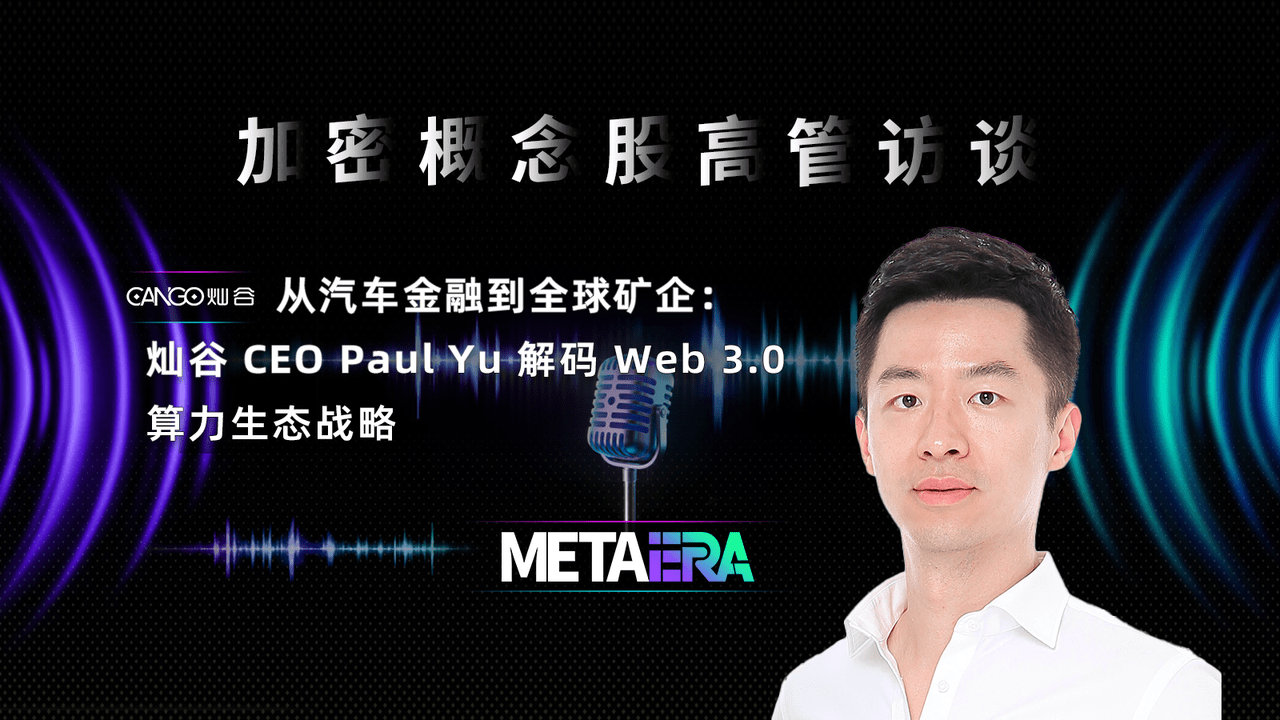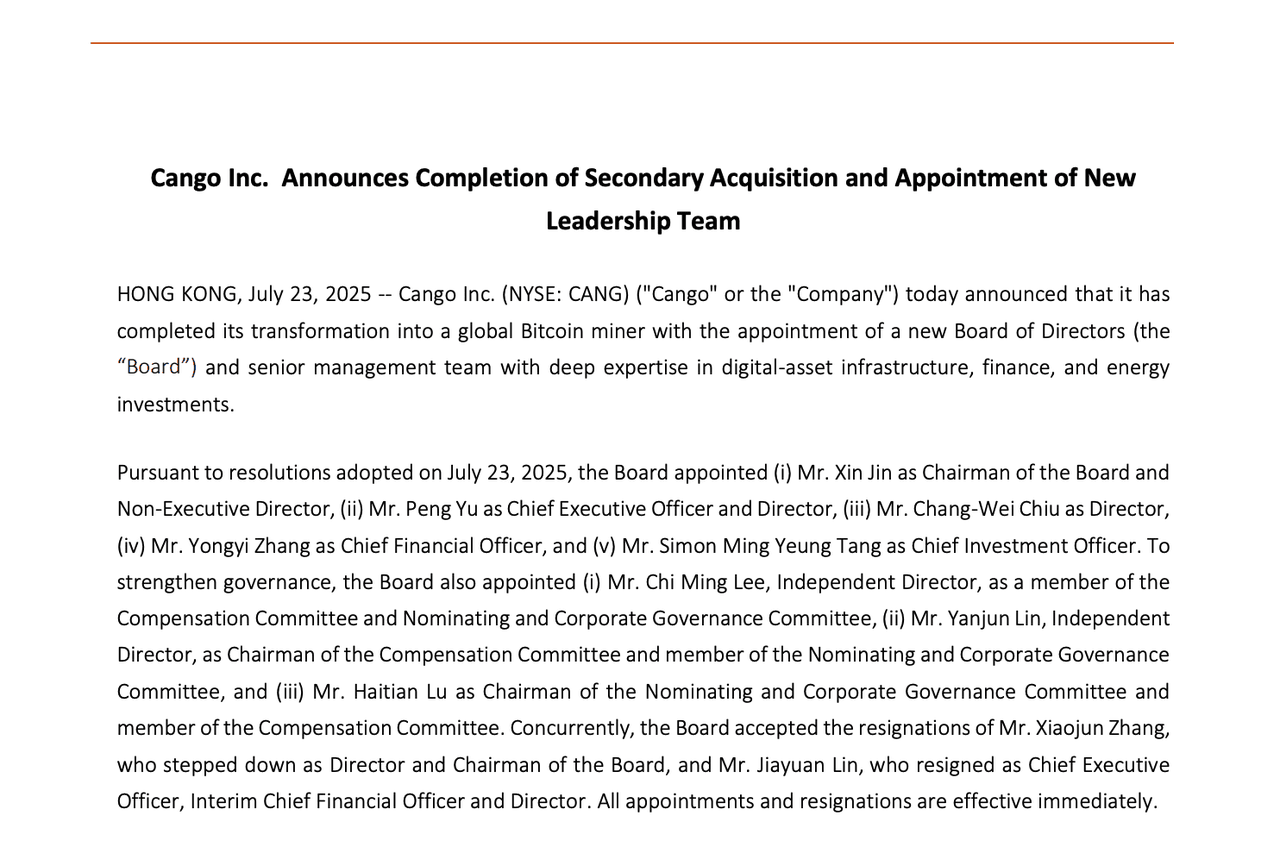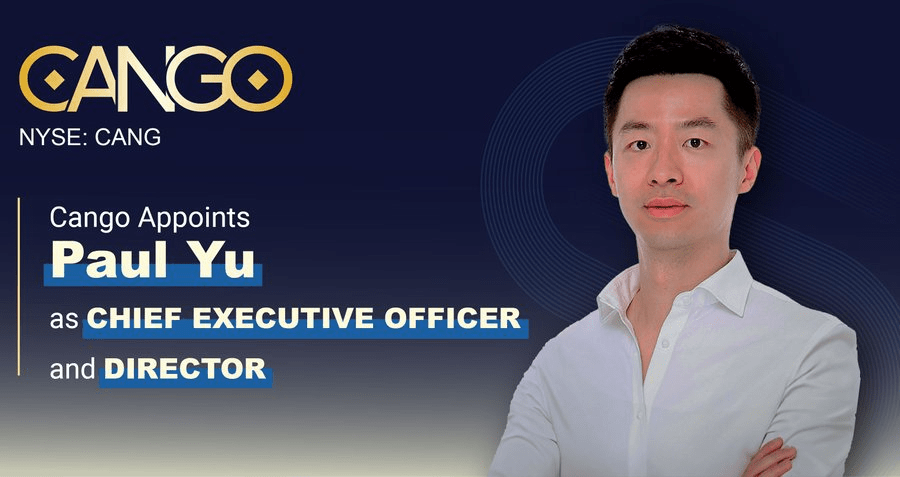Abstract: In this interview, MetaEra interviewed Paul Yu, the newly appointed CEO and director of Cango - a senior builder and entrepreneur with over 18 years of experience in Bitcoin mining, energy infrastructure, cross-border mergers and acquisitions and asset management, who is leading Cango on a new growth path.
Article Author: Lesley
Article Source: MetaEra
Key points
• Compared to a simple coin-holding strategy, using mining as a strategic path to enter Web 3.0 has three advantages: strong anti-volatility ability, stable cash flow resilience, and the potential for synergistic asset appreciation.
• Cango does not regard mining as the ultimate goal, but rather uses mining to establish a long-term ability to control electricity resource costs and optimize efficiency, laying the foundation for the company's long-term development.
• The essence of traditional enterprises entering Web 3.0 is to exchange physical resources for on-chain value anchoring. Only by achieving breakthroughs in the three dimensions of technological innovation, compliance construction, and economic model optimization can we truly leverage strengths, avoid weaknesses, and move forward steadily and far.
The Web 3.0 strategy and layout of listed companies have become a hot topic of increasing public concern. Against this backdrop, MetaEra officially launched the "High-end Dialogue" series of interviews with executives of crypto concept stocks. We will have conversations with the corporate leaders who dare to take the lead in the wave of digital transformation, and through the first perspective of decision-makers, deeply discuss their strategic layout, business innovation, and financial innovation, to provide prospective insights for industry participants.

In November 2024, Cango Inc. (NYSE: CANG), a NYSE-listed company that has been deeply involved in the auto finance field for many years, decisively announced its entry into the Bitcoin computing power mining field, thereby coping with the growth bottleneck of its traditional main business and becoming a pioneer for listed companies to explore the Web 3.0 track. On July 23, 2025, Cango announced the completion of a second acquisition and the simultaneous appointment of a new management team with rich blockchain experience, marking the company's formal completion of its layout for transformation into a Bitcoin mining company.

In this interview, MetaEra interviewed Paul Yu, the newly appointed CEO and director of Cango - a senior builder and entrepreneur with over 18 years of experience in Bitcoin mining, energy infrastructure, cross-border mergers and acquisitions and asset management, who is leading Cango on a new growth path.
From Auto Finance to Global Mining Company: Cango's Gorgeous Transformation
Looking back on its development history, Cango was once an important participant in China's auto finance sector. In 2018, the company successfully landed on the New York Stock Exchange, becoming a Chinese company ringing the bell on Wall Street. However, with the changing business environment of internet finance, facing traditional business bottlenecks, Cango urgently needs to find new growth engines.
In November 2024, Cango officially entered the crypto field and fully transformed into a "Bitcoin mining company," and its business quickly expanded to North America, the Middle East, South America, and East Africa. On July 23, 2025, Cango announced the appointment of a new board of directors and management team with professional backgrounds in digital asset infrastructure, finance, and energy investment, officially completing the full transformation to a Bitcoin mining company.
As a senior practitioner in the blockchain industry, why did Paul Yu join Cango at this time, and take the position of CEO and director? MetaEra did an exclusive interview with him.

Speaking of the reason for joining Cango, Paul Yu said frankly that he was impressed by the company's transformation courage. "As a long-term practitioner in the Bitcoin mining field, I deeply agree with Cango's strategic transformation courage," Paul Yu said, "The company has increased its computing power from zero to 50 EH/s, the second in the world, in only 9 months through cash acquisition and equity swap. This efficient execution is highly consistent with my philosophy of deeply cultivating the industry."
He pointed out that the success of Cango's transformation cannot be separated from the accurate judgment of market timing: "When the transaction was finalized in 2024, Bitcoin (BTC) was still at a cycle low, the price of mining machines was low (at that time, the cost-effective model S19 XP was used), and the computing power competition was not yet fierce, laying a low-cost advantage for subsequent profitability." He cited data to introduce that in the fourth quarter of 2024, the company's Bitcoin mining revenue reached 653 million yuan (approximately 89.5 million US dollars), the total quarterly revenue was 668 million yuan (approximately 91.5 million US dollars), an increase of more than 400% year-on-year, completely reversing the shrinkage of the auto business."
Paul Yu is full of confidence in Cango's future. The specific reason behind this is that Cango's Q1 2025 financial report shows strong financial resilience. He introduced, "As of the end of the first quarter of 2025, the company held cash, cash equivalents and short-term investments totaling RMB 2.5 billion (approximately US$346.7 million), with a cumulative holding of 2,475 Bitcoins."
He pointed out that joining Cango coincided with the policy wind: "Many states in the United States have included Bitcoin in their fiscal reserves, pushing the coin price to break through 120,000 US dollars, opening up a profit window for mining companies." Based on this background, Paul Yu said, "Under the triple resonance of business foundation, capital strength, and industry opportunities, I look forward to leading the team to achieve a leap from transformation exploration to global leadership."
Cango's transformation is not only an adjustment of business direction, but also a true reflection of listed companies building a new growth curve in the crypto era.
Laying out the Future: How Will Cango Build a Global Computing Power Ecosystem?
Traditional companies enter the crypto market in different ways. Some choose to use coin-holding strategies or invest in blockchain technology, while others get involved in this emerging field through mergers and acquisitions, cross-border cooperation, etc. However, facing the increasingly fierce crypto market competition, Cango chose to start with Bitcoin mining and build a globalized computing power ecosystem.
Strategic direction: Why choose mining instead of holding coins?
In the strategic selection of crypto companies, holding coins or mining is always a core issue that cannot be avoided. Facing the mainstream US stock companies' general choice of the "purchase and hold" strategy, Cango decisively chose the "mining production" track early on.
Paul Yu believes that compared to a simple coin-holding strategy, using mining as a strategic path to enter Web 3.0 has three advantages:
・Anti-volatility ability: can hedge coin price fluctuations by dynamically adjusting the mining machine start-up rate, and maintain the average BTC holding cost within a controllable range;
・Cash flow resilience: With the current computing power scale of 50 EH/s, Cango produces more than 20 BTC per day, providing the company with stable cash flow;
・Asset synergistic appreciation: Mining machines, as physical assets, can be mortgaged and financed, forming a double leverage structure with BTC liquid assets."
At the same time, geopolitical factors have also powerfully promoted this strategic choice. "The Trump administration's policy support for cryptocurrency has created an unprecedented strategic window for us," Paul Yu pointed out, "Especially in promoting the abolition of SAB 121 and encouraging state governments to include BTC in their fiscal reserves, a series of policies are substantially improving the operating environment for mining companies." Cango is also taking advantage of this policy wind to accelerate its layout in North America and the global market.
Paul Yu revealed that in order to better undertake the implementation of global strategies, Cango is also planning to establish a US local team and a US headquarters, demonstrating its global layout and emphasis on the North American market.
But Paul Yu also emphasized that mining is not the end, but the starting point for Cango to enter the era of computing power. Under his leadership, Cango is steadily expanding its business and establishing new growth points in the fields of Web 3.0 and energy computing power.
Strategic Goal: Starting from Mining, Going to the Future of Flexible Computing Power
Cango's future layout is not only a horizontal expansion of business, but a systematic upgrade based on a deep understanding of the relationship between energy and computing power.
"Cango started with Bitcoin mining and built large-scale computing power operation capabilities, the core purpose of which is to accumulate relevant experience in 'energy acquisition and management,' such as choosing low electricity price areas and conducting dynamic electricity arbitrage," Paul Yu explained. Cango does not regard mining as the ultimate goal, but rather uses mining to establish a long-term ability to control electricity resource costs and optimize efficiency, laying the foundation for the company's long-term development.

Based on the above assumptions, in Paul Yu's strategic blueprint, Cango's development path is clearly divided into three stages - from efficiency release to energy integration, and finally to the positioning leap of the computing power scheduling platform. Based on this, Paul Yu introduced Cango's future goals to MetaEra.
・Short-term goal: To release the value of 50 EH/s of computing power by improving operational efficiency, including improving operational efficiency, upgrading machines, etc., and reduce the cost of a single BTC by selectively acquiring low-electricity price mines.
・Mid-term strategy: Build a "energy + computing power" dual-drive. Pilot "green electricity + energy storage" projects in renewable energy-rich areas to make the electricity cost of some mines close to zero, and convert surplus electricity into a source of income. At the same time, reuse mining facilities to provide HPC (High-Performance Computing) services to AI companies, opening up a second growth curve.
・Long-term positioning: to become a flexible computing power scheduler, dynamically allocating resources to BTC mining and AI computing, forming a composite business model of "mining revenue + AI service fees + green electricity transactions."
Regarding Cango's future positioning, Paul Yu summarized the advantages of the current strategy: "Cango will focus on energy value upgrade, realize zero marginal cost power supply for some mines through green electricity infrastructure, and gradually provide HPC services for AI customers, and finally create a flexible computing power pool, thereby significantly improving asset utilization and anti-cycle capabilities."
In the current situation where the global computing power demand is booming and the trend of AI and crypto infrastructure integration is becoming increasingly clear, Cango's strategic layout is not only a restructuring of the traditional mining company model, but also expected to win a decisive advantage in cross-cycle growth.
Coin-Stock Integration Wave is Coming: The Second Growth Curve of Traditional Listed Companies?
Against the backdrop of the increasing integration of crypto assets and traditional finance, listed companies are becoming a key driver of this historic change.
Structural advantages of traditional listed companies in Web 3.0
Compared to crypto-native companies, traditional listed companies demonstrate irreplaceable structural advantages in Web 3.0 transformation. Paul Yu provided strong evidence for this view with Cango's practice. Paul Yu believes that Cango's core advantages are reflected in three dimensions.
The first is compliance genes. "The NYSE listing in 2018 has accumulated a mature compliance system for us," Paul Yu explained, "From SEC disclosure standards to cross-border regulatory response, this complete compliance framework is being fully migrated to Cango's new business." This compliance capability is particularly valuable in the current environment of tightening regulation.
The second is the light asset path. Cango chose to quickly enter the industry by acquiring second-hand mining machines, avoiding the market dilemma of tight supply and high prices of new machines, allowing Cango to quickly obtain industry-leading operating efficiency with relatively small capital investment. "The depreciation cost of a single coin of the S19XP model we use is only 13,000 US dollars, which is far lower than the cost of new machines in the same period," Paul Yu pointed out, "More importantly, we have established strategic partnerships with important industry participants including Bitmain and Antalpha to ensure steady development."
The third is strategic focus. "We always adhere to the principle of prioritizing cash flow quality and focus on building the hard power of computing power efficiency and energy infrastructure." Paul Yu emphasized. This focus strategy allows Cango to maintain a clear development direction in the complex and volatile crypto market, and invest limited resources in places with the most long-term value.
"In our view, the essence of traditional enterprises entering Web 3.0 is to exchange physical resources for on-chain value anchoring," Paul Yu concluded, "Only by achieving breakthroughs in the three dimensions of technological innovation, compliance construction, and economic model optimization can we truly leverage strengths, avoid weaknesses, and move forward steadily and far."
It should be noted that against the background of the integration of coins and stocks, the valuation logic of listed companies is also being redefined. Paul Yu said frankly that the trend of coin-stock integration will change the valuation method of enterprises. The valuation of listed companies needs to combine traditional discounted cash flow (DCF) and on-chain asset value (such as BTC holdings, computing power scale) dual model. This change puts higher demands on listed companies: they must establish a transparent and efficient information disclosure mechanism to bridge the gap in the understanding of Web 3.0 assets among traditional investors.
Cango Talks Stock Tokenization: Optimistic but Not Yet Involved
Speaking of the major trend of stock tokenization, Paul Yu showed both recognition and restraint.
"We recognize the potential of stock tokenization in enhancing liquidity, reducing investment thresholds, and optimizing capital efficiency. Investors can enjoy 24-hour global trading, on-chain real-time dividends, and other experiences. These innovations inject blockchain's efficient genes into traditional finance."
"Although industry innovation is exciting, Cango has not yet launched any substantive exploration of stock tokenization," Paul Yu admitted. "Our strategic priorities are clearly focused on two points: maximizing computing power efficiency and infrastructuring energy, which are the two pillars of Cango's leap from a 'mining company' to a 'green energy integrated service provider'."
Paul Yu said that Cango's current strategic focus is still concentrated on the two core areas of computing power and energy. This strategic focus of "doing something and not doing something" reflects the deep understanding of mature enterprises of resource allocation efficiency. In the current situation where opportunities abound in the Web 3.0 track, companies that can resist temptation and focus on core businesses are often more likely to build long-term competitive advantages.
Summary: Traditional Finance and Web 3.0 are Integrating
Cango's gorgeous transformation from a "auto finance enterprise" to a "Bitcoin mining enterprise" reflects another path choice for traditional listed companies in seeking a second growth curve. Against the backdrop of an increasingly friendly policy environment and continuous inflow of institutional funds, more and more traditional enterprises are starting to incorporate digital assets into their strategic considerations, and "coin-stock integration" is moving from concept to reality.
However, the success of the transformation is by no means accidental. The key to Cango's ability to become a global leading mining company in just 9 months lies in the precise timing, efficient resource allocation, and clear strategic positioning. This reminds us that Web 3.0 transformation tests not only the foresight of the company, but also the execution and risk control capabilities.
In today's increasingly prosperous Web 3.0 industry development, long-term builders are gradually replacing short-term speculators and becoming the dominant force in industry development. Cango's transformation is undoubtedly an important part of this transformation.

